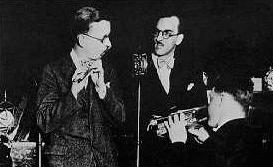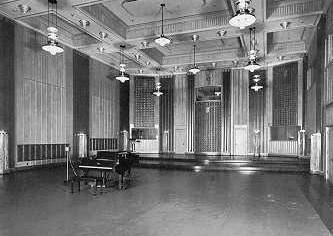In
making its debut, the infant WNBQ joined its sister AM radio station WMAQ, which
occupied an honored position as a pioneer station and NBC's Chicago flagship radio
station since November of 1931. In a larger sense, however, it was carrying on
the NBC tradition of broadcast pioneering, so ably begun in Chicago by WMAQ.
| Right: WMAQ's
first radio studio was a drapery decked room on the top floor of The Fair department
store on State Street. |
|
 |
Left: The
Three Doctors---Pratt, Sherman and Rudolph were featured on radio's popular 'Club
Matinee' from NBC Chicago. |
WMAQ was Chicago's
second radio station, going on the air April I2, 1922 under the joint ownership
of the Fair Store and the Chicago Daily News. Its heritage is not only that of
a pioneer radio station, but also as an incubator of talent which became world-renowned.
| Right: NBC
Chicago's Studio A was the most modern and elegant in the early 1930's. |
 |
Fred Waring's Pennsylvanians
made their first broadcast over WMAQ. So did George Arliss, Ben Hecht, Red Skelton
and a five-year-old youngster named Jackie Coogan.
WMAQ introduced such radio stars as Amos
'n' Andy, Fibber McGee and Molly,
the Great Gildersleeve and the Ameche brothers, Don and Jim.
 |
Left:
Marian
and Jim Jordan, better known as Fibber McGee and Molly, got their start in broadcasting
on WMAQ Radio.
|
The station was the
birthplace of the daytime serial drama-the 'soap opera', beloved of America's
housewives and in 1928 was the first station to broadcast a trans-Atlantic conversation
between John Gunther, then London correspondent of the Chicago Daily News, and
Hal O'Flaherty, foreign news editor of that newspaper.
|
|
| The "umbrella"
radio mobile unit of the 1930's (above) attracted as much attention
in its time as the sleek new Channel 5 Video Tape Mobile Unit (below)
equipped with the color camera for on location taping. |
|
|
WMAQ also played an
early role in the development of television with its experimental transmitter
W9XAP, established
in August, 1930. The wavering 45-line picture (compared to today's 525-line image)
featured such established radio stars as Sportscaster Hal Totten and Irene Wicker,
the Singing Lady.
|